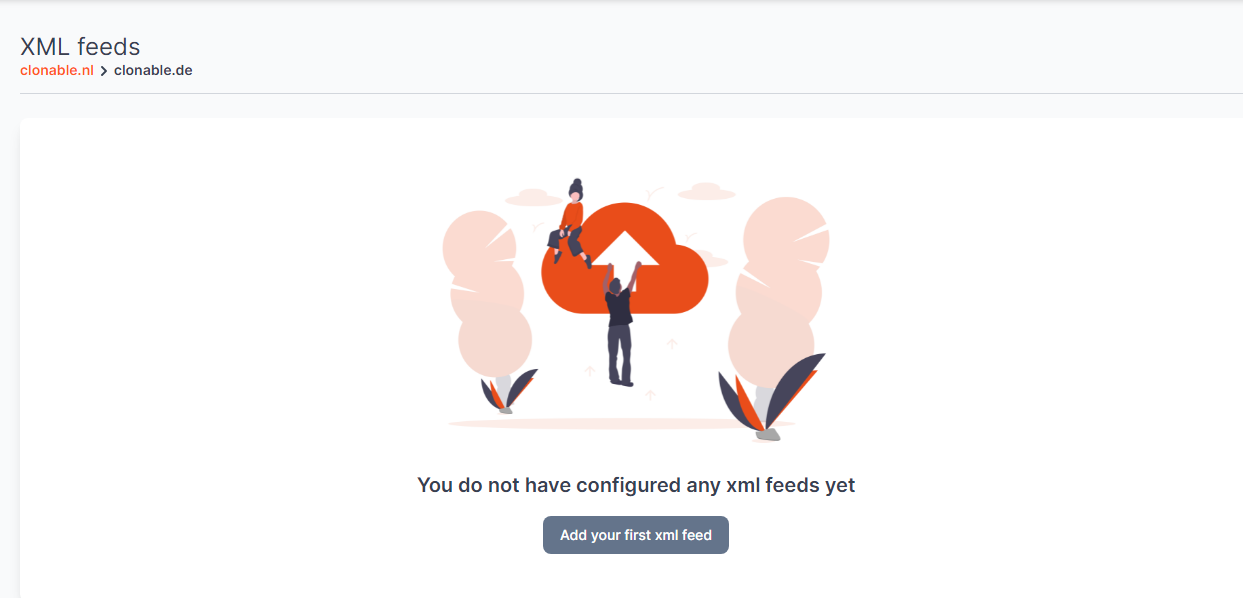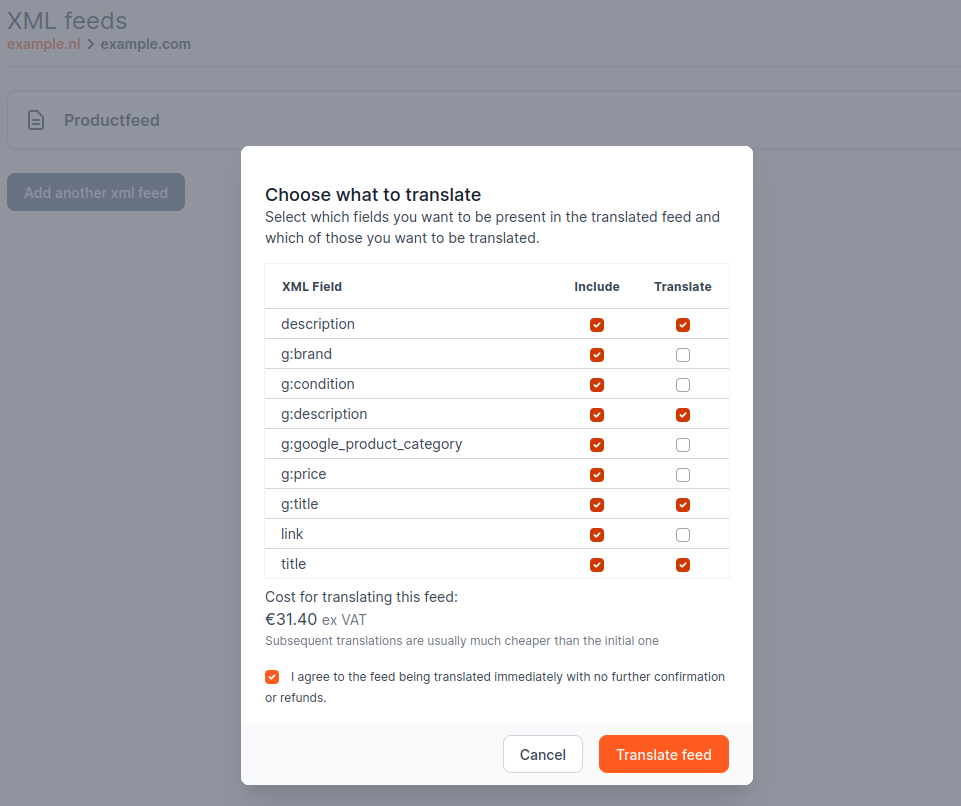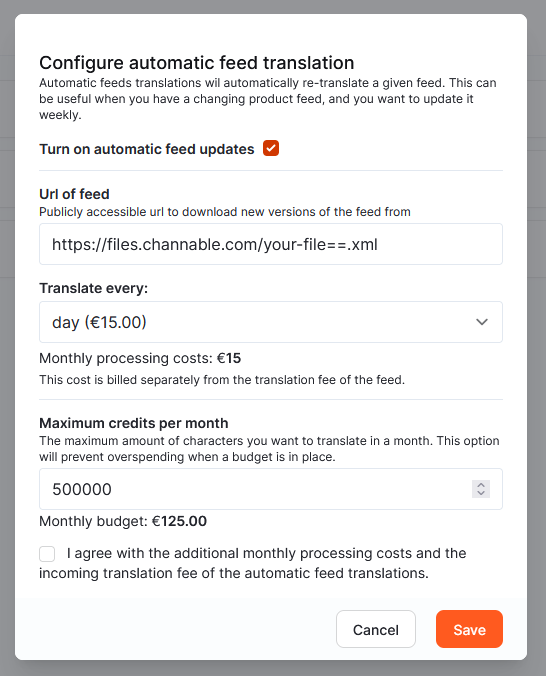XML feeds
With Clonable, it is also possible to translate the XML feeds of your site. XML feeds are usually shopping feeds. This allows your products to be found on Google shopping, for example.
We charge extra for translating XML feeds.
You might want to use Google Shopping for your clone to reach more visitors. For example, if you have a webshop for soccer shoes, it might be useful to put these soccer shoes in the French Google Shopping as well. You can then translate your existing product feed through Clonable and import it into Google Shopping.
To translate your XML feed, go to the backend of Clonable. In the menu on the left side, click on 'XML feeds'. Here you can add your XML file. Clonable will then translate it for you.

Feeds are translated with a lower priority than web pages. Due to this and to the fact that feeds often contain many and large text fragments, it can take a long time (several hours in case there are thousands of products) for a feed to be translated, especially when you translate a feed for the first time.
Exclude fields
Some fields such as price or links are not useful to translate. You can exclude these to reduce the cost of the translation by unchecking the checkbox under Translate for the field you do not want to translate. In addition, if you do not want this field to be in the translated feed either, you can uncheck the checkbox under Include. In the example below you can see that only the title and description are translated by Clonable. You can change these settings afterwards by re-uploading the feed.

Clonable will indicate exactly how much translating the XML feed will cost. That way you can consider whether or not you think it's worth the cost, or if you might want to resize the file. When you upload a second version of the same XML feed, previously translated segments will not be included in the cost. This means that non-adapted elements will not be charged again when you upload a new version of your feed.
Urls in the feed
Domains in the translated feed are automatically replaced by the domain of the clone. For example, if you have a clone from https://www.clonable.net to https://www.clonable.nl, and you have the following product in your feed:
<product>
<title>Example product</title>
<price>12,50</title>
<product:url>https://www.clonable.net/products/example-product</title>
</product>
Then this product is translated as follows:
<product>
<title>Voorbeeld product</title>
<price>12,50</title>
<product:url>https://www.clonable.nl/producten/voorbeeld-product</title>
</product>
This also includes the url translations, which ensures that you don't get 301 redirects from the feed. The feed will not create new url translations, but only use existing url translations.
If you use a subfolder clone, Clonable will also automatically include the subfolder in the urls of the feed.
Other domains in the feed
Clonable leaves other domains in your feed alone by default. This has the effect that if you use another domain for your product urls, you have to replace it separately with a substitution rule.
Updating feeds
When you have added new products to your site, you can update the translated feed by clicking on the cog in the list of feeds near the feed you want to update. You can then upload the new version of your original feed and if necessary, change the settings for the fields to be translated. Again, you will see how much the updated translation will cost.
Automatic updating
With Clonable, it is possible to update a product feed automatically. External tools such as Channable are often used to create product feeds for a webshop. Clonable offers the option to update your translated feed automatically, so your translated feed is always up-to-date.
You can create an automatic feed in 2 ways:
- You can create a new feed and choose the ‘Dynamic feed’ type.
- You can update an existing feed so that it also uses a feed url.
Settings of the automatic feed
Clonable provides a number of settings with which to configure the automatic feed. These settings indicate where the feed is located, how often the feed should be checked, aswell as the maximum cost of the feed.

Translate every
You can set how often Clonable should check the feed for changes or new translations. The price for this is charged separately from the actual translation cost of the feed. You can choose from the following options:
- Once a month (no extra cost) This option is selected by default when configuring the feed
- Once a week (€10 p/m)
- Once a day (€15 p/m)
- 2 times a day (€25 p/m)
- Every 2 hours (€30 p/m)
- Every hour (€35 p/m)
Maximum credits per month
With an automatic feed, it is mandatory to set a budget. With this budget, you specify the maximum amount the feed can cost per month. You select a maximum number of credits, and then the feed will automatically calculate how much it would cost. This means that you will only be billed based on the changes made to the feed. If the feed does not change, you will not pay any extra costs for translating it.
When is my automatic feed (not) translated?
Your feed is only translated when there is enough budget available for the feed. This means that the feed automatically stops being translated when there is not enough budget available. This can happen for example, when you add a lot of products to the feed at once. As soon as your feed-translation has reached its maximum amout of credits, Clonable will automatically inform you via email that the feed will no longer be translated.
How do I restart translations?
You can restart translations in 2 ways. You can either increase the budget of your feed, which is a good option if you have only added a few products, or made some minor changes to the feed.
Or you can upload a new version of the feed, if you've added a large number of products or changed a lot of products. This has the advantage that you don't have to increase the budget for the automatic feed, but instead pay a one-off cost for the changes in the feed.
Where can I find my translated feed?
In the overview of your feeds, you can download both the translated and the original version of each feed. You can also copy the link to the translated version of your feed to your clipboard. This link is also available for third party services.
Voorbeelden
Google Shopping
Google Shopping is ideal for getting new customers quickly with your cloned webshop. In fact, you will be visible in the most widely used search engine, which makes it a good tool to test and expand. Make sure you upload a feed that is suitable for Google Shopping. If it is not, make sure you use an integrator (Channable, Channelengine, Effectconnect, etc.) to make sure it is. Clonable will then either translate the feed dynamically or all at once.
Bol.com
In the Netherlands Bol.com 1 of the largest webshops where you can offer your products as a product provider. This can be done in Dutch and in French (for Wallonia). Make sure you upload a feed suitable for Bol.com. If this is not the case, make sure you use an integrator (Channable, Channelengine, Effectconnect, etc.) to arrange this. Clonable will then either translate the feed dynamically or all at once.
Amazon
Amazon is the world's largest marketplace to offer your products. This can be done in many different languages. You can give your sales a big boost if you offer your products in different languages, assuming you can provide the logistics to do so. Make sure you upload a feed suitable for Amazon. If it is not, make sure you use an integrator (Channable, Channelengine, Effectconnect, etc.) to make sure it is. Clonable will then either translate the feed dynamically or all at once
Affiliate marketing platforms such as Awin / Tradetracker / Daisycon
Want to get started with online marketing abroad? Then consider affiliate marketing. With affiliate marketing, you can quickly generate more visibility and sales, especially if you spend enough time configuring and contacting affiliates. Make sure you upload a feed suitable for the platform in question. If this is not the case, make sure you use an integrator (Channable, Channelengine, Effectconnect, etc.) to do so. Clonable will then either translate the feed dynamically or all at once.